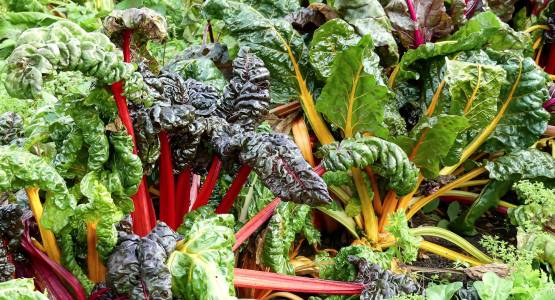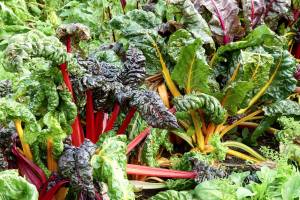A guide to growing swiss chard in a greenhouse

A Guide to Growing Swiss Chard in a Greenhouse
Swiss chard is a versatile, nutrient-packed leafy green that can add beauty and flavor to your meals. Its vibrant stalks, ranging from ruby red to sunshine yellow, are as visually appealing as they are delicious. If you’re eager to grow this hardy vegetable year-round, a greenhouse provides the perfect controlled environment. This guide will walk you through the steps of growing Swiss chard, from seed to harvest, along with a short recipe to showcase its culinary potential and recommendations for the best varieties.
Why Grow Swiss Chard in a Greenhouse?
Swiss chard thrives in cool to moderate temperatures, making it an excellent choice for greenhouse cultivation. Greenhouses offer several benefits for growing chard:
- Temperature Control: Chard grows best between 50°F and 85°F (10 degrees celsius – 27 degrees celsius) , and a greenhouse allows you to maintain this range.
- Pest Protection: Slugs, aphids, and leaf miners are common threats to chard, but a greenhouse helps minimize exposure.
- Extended Growing Season: With a greenhouse, you can grow Swiss chard year-round, even in colder climates.
- Better Growth Conditions: Greenhouses protect against harsh weather, ensuring steady growth and vibrant, healthy leaves.
Step 1: Choosing the Best Swiss Chard Variety 

Swiss chard varieties differ in color, flavor, and growth habits. Some of the most popular options include:
- Bright Lights: Known for its colorful stems in red, yellow, orange, and pink. It’s as ornamental as it is edible.
- Fordhook Giant: A classic variety with broad, dark green leaves and thick white stalks. It’s hardy and highly productive.
- Ruby Red (Rhubarb Chard): Features deep green leaves with striking red stems. Its slightly earthy flavor pairs well with hearty dishes.
- Peppermint: White stems striped with pink, offering a sweeter flavor and beautiful appearance.
For greenhouse growers, Bright Lights is an excellent choice due to its quick growth and tolerance to varying conditions, but Fordhook Giant is a close second for its resilience and high yield.
Step 2: Preparing Your Greenhouse
Optimal Setup:
- Lighting: Swiss chard requires 6-8 hours of light daily. Ensure your greenhouse has ample natural light or supplement with grow lights.
- Soil: Use well-draining, nutrient-rich soil with a pH between 6.0 and 7.0. Adding compost or organic matter improves fertility.
- Temperature Control: Keep the greenhouse between 50°F and 85°F. Ventilation is essential to avoid overheating.
- Humidity: Maintain moderate humidity (40-60%) to promote healthy growth and prevent fungal diseases.
Containers vs. Beds:
- Raised beds or ground soil in the greenhouse work well, but containers or grow bags are great for small spaces. Use pots at least 8-10 inches deep to allow the roots to develop.
Step 3: Planting Swiss Chard
When to Plant:
You can plant Swiss chard seeds year-round in a greenhouse. However, for the best results:
- Spring Planting: Start seeds 4-6 weeks before the last frost.

- Winter Planting: Start seeds in late fall for a winter harvest.
How to Plant:
- Sowing Seeds:
- Soak seeds in water for 24 hours to improve germination.
- Plant seeds ½ inch deep and 2 inches apart in rows or containers.
- Spacing:
- Thin seedlings to 6-8 inches apart once they reach 2 inches tall.
- Wider spacing allows for larger leaves and better air circulation.
- Watering:
- Keep the soil consistently moist but not waterlogged. Water deeply once or twice a week.
Step 4: Caring for Swiss Chard
Fertilizing:
Swiss chard is a heavy feeder. Use a balanced fertilizer (10-10-10) every 3-4 weeks, or topdress with compost to supply nutrients.
Pruning and Harvesting:
- Harvest Leaves Regularly: Begin harvesting when leaves are about 6-8 inches long. Pick the outer leaves first to allow the inner leaves to continue growing.
- Avoid Overharvesting: Leave at least one-third of the plant’s leaves intact to ensure regrowth.
Pest and Disease Management:
- Pests: Inspect plants for aphids or slugs. Use neem oil or insecticidal soap as needed.
- Diseases: Good ventilation and proper spacing help prevent fungal issues like powdery mildew.
Step 5: Harvesting and Storing Swiss Chard
Swiss chard is ready for harvest 50-60 days after planting. For baby greens, harvest earlier at 30 days. After harvesting, rinse leaves thoroughly and store them in a plastic bag in the refrigerator for up to a week. To keep stems crisp, wrap them in a damp paper towel.
A Simple Swiss Chard Recipe: Garlicky Sautéed Chard
Showcase the fresh flavors of your homegrown Swiss chard with this quick and easy recipe. Perfect as a side dish or a topping for pasta or grain bowls.
Ingredients:
- 1 large bunch of Swiss chard (about 8-10 leaves)
- 2 tablespoons olive oil
- 3 garlic cloves, minced
- Salt and pepper to taste
- A squeeze of fresh lemon juice (optional)
Instructions:
- Wash the Swiss chard thoroughly. Separate the stems from the leaves. Chop the stems into 1-inch pieces and roughly chop the leaves.
- Heat olive oil in a large skillet over medium heat. Add the garlic and sauté until fragrant, about 1 minute.
- Add the chard stems to the skillet and cook for 3-4 minutes until tender.
- Add the leaves, stirring until they wilt, about 2-3 minutes. Season with salt and pepper.
- Finish with a squeeze of lemon juice for a bright, tangy flavor.
Enjoy your sautéed Swiss chard as a healthy addition to any meal!
Why Swiss Chard Deserves a Spot in Your Greenhouse
So in this guide to Growing Swiss Chard in a Greenhouse, we have seen that Swiss chard isn’t just easy to grow; it’s also a nutritional powerhouse. Packed with vitamins A, C, and K, as well as iron and magnesium, it’s a great way to boost your diet. Growing it in a greenhouse ensures a steady supply of fresh greens, no matter the season.
Whether you’re a seasoned gardener or just starting out, Swiss chard is a rewarding crop that’s beautiful, delicious, and versatile. With the tips outlined in this guide, you’ll be well on your way to enjoying a bountiful harvest of this leafy green superstar.
